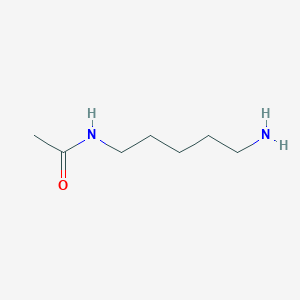| General Information of MET (ID: META00830) |
| Name |
N-Acetylcadaverine
|
| Synonyms |
Click to Show/Hide Synonyms of This Metabolite
Acetylcadaverine; Monoacetyl cadaverine; Monoacetylcadaverine; N-(5-Aminopentyl)acetamide
|
| Source |
Endogenous;Food;Microbial
|
| Structure Type |
Carboxylic acid derivatives (Click to Show/Hide the Complete Structure Type Hierarchy)
Organic acids and derivatives
Carboxylic acids and derivatives
Carboxylic acid derivatives
|
| PubChem CID |
|
| HMDB ID |
|
| Formula |
C7H16N2O
|
| Structure |
<iframe style="width: 300px; height: 300px;" frameborder="0" src="https://embed.molview.org/v1/?mode=balls&cid=189087"></iframe>
|
 |
|
3D MOL
|
2D MOL
|
|
Click to Show/Hide the Molecular/Functional Data (External Links/Property/Function) of This Metabolite
|
| ChEBI ID |
|
| FooDB ID |
|
| ChemSpider ID |
|
| Physicochemical Properties |
Molecular Weight |
144.21 |
Topological Polar Surface Area |
55.1 |
| XlogP |
-0.3 |
Complexity |
93.6 |
| Heavy Atom Count |
10 |
Rotatable Bond Count |
5 |
| Hydrogen Bond Donor Count |
2 |
Hydrogen Bond Acceptor Count |
2 |
| Function |
N-Acetylcadaverine is the acetylated form of the polyamine cadaverine. Cadaverine is produced by the breakdown of amino acids in living and dead organisms and is toxic in large doses. Cadaverine is largely responsible for the foul odor of putrefying flesh, but also contributes to the odor of such processes as bad breath and bacterial vaginosis. Cadaverine is also found in semen. Polyamines (and their acetylated forms) are known to be closely related with cell growth, cell proliferation, and synthesis of proteins and nucleic acids. Their concentrations are adjusted either by regulating the activity levels of the biosynthetic and catabolic reactions or by controlling the net direction of polyamine acetylation-deacetylation. In Alzheimer's disease (AD), the neurotoxic amyloid β-peptide is known to up-regulate polyamine metabolism by increasing ornithine decarboxylase activity and polyamine uptake by initiating free radical damage. Because of these findings, polyamines have been considered to play an important role in response to neurodegenerative conditions. Altered levels of polyamines have been found in tissue, hair and body fluids of patients with neuromuscular diseases and neurodegenerative conditions. N-Acetylcadaverine has been found to be a metabolite of several bacteria species (https://www.sciencedirect.com/science/article/pii/S209580991730423X).
|
|
Regulatory Network
|
|
|
|
|
|
|
|
|
 click to show the details of this protein
click to show the details of this protein
 click to show the details of experiment for validating this pair
click to show the details of experiment for validating this pair

